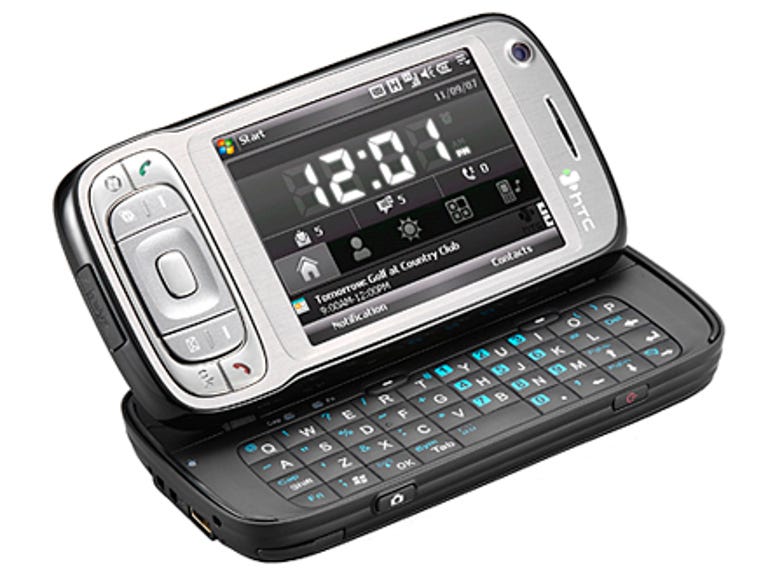 Why You Can Trust CNET
Why You Can Trust CNET HTC TyTN II review: HTC TyTN II
It may not be a quantum leap compared with the 838 Pro, but the TyTN II maintains what power users loved in the previous iteration — with a few extras.
Design
At 112 x 59mm and 19mm deep, the TyTN II is no shrinking violet. There's no denying the weighty TyTN II handset lives up to its name with its somewhat "titanic" proportions, but this is offset to a degree by the muted colour scheme and rounded corners that together make the TyTN II quite a stylish device. Much to the relief of CNET.com.au's resident A/V specialist Ty Pendlebury, only the upper half of the TyTN II's slider form is finished in the fingerprint-loving piano black he loathes so much. The underside of the handset and the QWERTY keyboard are made from a much more finger-friendly matte-black soft-touch plastic.
The Good
The Bad
The Bottom Line
Although, it's not the piano black finish where fingerprints are going to drive you crazy. The TyTN II sports a large 2.8-inch QVGA (320x240) touchscreen display, which is adequate but not excellent, and smears like crazy. Perhaps we've been spoiled recently, but after using the i-mate Ultimate series VGA (640x 480) resolution displays, we think Windows Mobile devices, more than others mobile phones, require the higher resolution graphics to help navigate the complex user interface. In comparison to the i-mates, the HTC display appears slightly duller and, obviously, less sharp.
One area where the TyTN II excels over the equally hefty i-mate Ultimate series handsets is the inclusion of a full QWERTY keyboard under the slide. Unlike a lot of QWERTY keypads we see on mobile devices, the TyTN II features one that is very easy to use. The soft-touch keys are slightly raised off the surface of the pad providing important definition between the keys and making "two-thumb" typing a breeze. With the slider open the screen can also tilt forward to roughly a 45 degrees angle, turning the TyTN II into a tiny laptop. While this is a nifty touch, we actually found this made the top line of keys harder to access and preferred using the keyboard without tilting the screen.
Features
It seems Windows Mobile PDA-phones are becoming uniformly complete devices. When exploring these smartphones lately we've found ourselves scanning the devices, not to discover what features are available, but to locate which features were missing. The TyTN II runs Windows Mobile 6 and has HSDPA and Wi-Fi for data transfers. It also supports all mobile network frequencies, all popular e-mail protocols, as well as AD2P stereo Bluetooth, and has a built-in 3-megapixel camera. In addition, the TyTN II has an onboard GPS chipset and is apparently bundled with CoPilot 7 navigation software, although our test unit was lacking the software and we had to resort to Google Maps to test some of the GPS functionality.
Similar to other HTC products, the TyTN II features the standard HTC Windows Mobile interface shell and HTC's patented TouchFlo technology. Now while this means the TyTN II's interface looks like the Touch and the Touch Dual, the funky "spinning cube" menu from those phones is notably absent. This won't affect the TyTN's performance, it just means it lacks the "wow-factor" you'd otherwise be able to show off to your mates.
Performance
The TyTN II runs on similar hardware to the HTC Touch Dual; a 400Mhz Qualcomm processor with 128MB of RAM. Predictably, the processing results are very similar to the Touch Dual; which are definitely useable but not outstanding. We found navigating the TyTN II's "Today" menu to be fast and responsive, but once we started to open a few applications or settings menus, and required the device to multitask, we started to see noticeable processing lag.
Web browsing on the TyTN II is a joy with the HSDPA data speeds. A jog-wheel on the side of the TyTN II makes short work of scrolling over long text-based sites , and hyperlinks are easily selected using the touchscreen. Our only criticism of the browsing experience is the mobile Internet Explorer browser itself, although we look forward to this being remedied by the next generation of freeware mobile browsers from Skyfire and Firefox.
Our main concern with the TyTN II is poor battery life. This is a common problem with Windows Mobile handsets at the moment and we noted a similar problem as being a major short-coming of the i-mate smartphones. Given light usage the TyTN II seems capable of a standby battery life of about three days. Any heavier use, about an hour of Web access for example, and the battery barely lasted a day before needing to be charged again. If you imagine using the GPS for turn-by-turn directions while your push e-mail updates frequently, and then add standard calls and messaging, we can foresee the need to carry the charging pack around with the phone.
Overall
For business users looking specifically for a Windows Mobile device the choice between handsets is much harder than in other areas of mobile phones. Most have the best connectivity options available, most have the most popular input options, including touchscreens, and most are on the wrong side of enormous and suffer poor battery life. Moreover, with the majority of these PDA-phones priced between AU$900 and AU$1,100, the choice may come down to aesthetics alone.
There is quite a lot to like about HTC's TyTN II. The inclusion of GPS should turn a few heads in its direction, although, if you can do without the QWERTY keyboard, you may want to wait for the smaller, GPS-enabled HTC Cruise which is expected to be released in Feb/March 2008.


